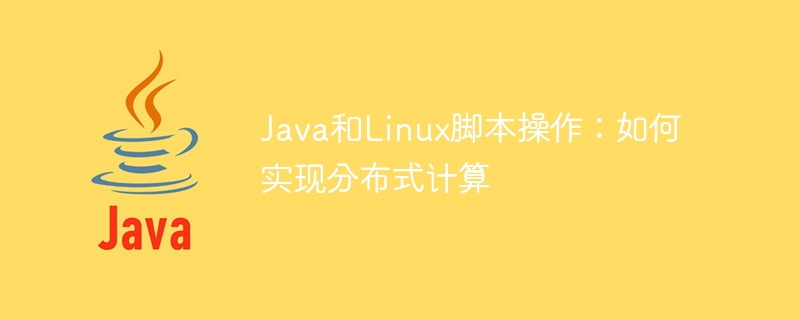Java和Linux腳本操作:如何實作分散式運算

Java與Linux腳本操作:如何實作分散式運算
摘要:
隨著雲端運算與大數據時代的到來,分散式運算作為一種高效處理大規模資料和複雜計算任務的方法,並廣泛應用了。本文將探討如何使用Java和Linux腳本操作實現分散式計算,並透過具體的程式碼範例說明。
關鍵字:分散式運算、Java、Linux腳本、雲端運算、大數據
引言:
隨著網路和運算技術的快速發展,人們對資料處理速度和運算能力的要求也越來越高。分散式運算作為一種高效處理大規模資料和複雜運算任務的方式,被廣泛應用於雲端運算、大數據、人工智慧等領域。本文將介紹如何使用Java和Linux腳本操作實現分散式計算,並透過具體的程式碼範例進行說明。
一、分散式運算的原理和優勢
分散式運算是將運算任務分解成多個子任務分別在多台電腦上進行,並且透過網路進行協調和通信,最終將分解的結果進行整合的一種計算模式。分散式運算具有以下幾個優點:
- 高效處理大規模資料:分散式運算可以將任務分解成多個子任務並行處理,大大提高了處理大規模資料的效率。
- 提高運算能力:分散式運算利用多台電腦的平行運算能力,能夠處理更複雜且耗時的運算任務。
- 提高系統的可靠性和容錯性:由於任務可以在多台電腦上進行並行處理,一台電腦故障不會影響整個系統的運作。
二、使用Java實現分散式運算
Java作為一種廣泛應用於企業級開發的程式語言,提供了豐富的並發程式設計和網路程式設計的支持,非常適合用於實現分散式計算。
-
使用Java的同時程式庫:Java提供了Executor框架和Fork/Join框架,可以很方便地實現任務的平行處理和任務的分割與整合。
範例程式碼:import java.util.concurrent.ExecutorService; import java.util.concurrent.Executors; import java.util.concurrent.Future; public class DistributedComputingDemo { public static void main(String[] args) { // 创建一个具有固定线程数的线程池 ExecutorService executorService = Executors.newFixedThreadPool(10); // 提交多个任务给线程池并获取Future对象 Future<Integer> future1 = executorService.submit(new Task(1, 100)); Future<Integer> future2 = executorService.submit(new Task(101, 200)); // 获取任务的计算结果 try { System.out.println("Task1 result: " + future1.get()); System.out.println("Task2 result: " + future2.get()); } catch (Exception e) { e.printStackTrace(); } // 关闭线程池 executorService.shutdown(); } } class Task implements Callable<Integer> { private int start; private int end; public Task(int start, int end) { this.start = start; this.end = end; } @Override public Integer call() throws Exception { int sum = 0; for (int i = start; i <= end; i++) { sum += i; } return sum; } }登入後複製 使用Java的遠端方法呼叫(RMI):Java的RMI機制可以實現遠端電腦之間的方法調用,進一步擴展了分散式計算的應用範圍。
範例程式碼:import java.rmi.Remote; import java.rmi.RemoteException; public interface Calculator extends Remote { int add(int a, int b) throws RemoteException; int multiply(int a, int b) throws RemoteException; } import java.rmi.RemoteException; import java.rmi.registry.LocateRegistry; import java.rmi.registry.Registry; import java.rmi.server.UnicastRemoteObject; public class CalculatorImpl extends UnicastRemoteObject implements Calculator { public CalculatorImpl() throws RemoteException { super(); } @Override public int add(int a, int b) throws RemoteException { return a + b; } @Override public int multiply(int a, int b) throws RemoteException { return a * b; } public static void main(String[] args) { try { Calculator calculator = new CalculatorImpl(); Registry registry = LocateRegistry.createRegistry(12345); registry.rebind("calculator", calculator); System.out.println("CalculatorImpl bound"); } catch (Exception e) { e.printStackTrace(); } } } import java.rmi.registry.LocateRegistry; import java.rmi.registry.Registry; public class DistributedComputingDemo { public static void main(String[] args) { try { Registry registry = LocateRegistry.getRegistry("localhost", 12345); Calculator calculator = (Calculator) registry.lookup("calculator"); System.out.println("1 + 2 = " + calculator.add(1, 2)); System.out.println("3 * 4 = " + calculator.multiply(3, 4)); } catch (Exception e) { e.printStackTrace(); } } }登入後複製
三、使用Linux腳本實作分散式運算
除了Java,Linux腳本語言如Shell腳本也可以用來實現分散式運算。 Linux腳本可以利用SSH協定和執行遠端指令的功能,實現在多台電腦上進行任務的並行化處理。
範例程式碼:
#!/bin/bash
# 定义需要执行的远程命令
command="java -jar compute.jar 1000 2000"
# 定义计算机列表
hosts=("host1" "host2" "host3" "host4")
# 循环遍历计算机列表,并在每台计算机上执行远程命令
for host in "${hosts[@]}"
do
ssh $host "$command" &
done
# 等待所有计算机的任务执行完成
wait
echo "All tasks have been completed."結論:
本文透過介紹分散式運算的原理和優勢,以及使用Java和Linux腳本操作實現分散式運算的具體方法和範例程式碼,希望讀者能夠對分散式運算有更深入的了解,並且能夠在實際開發中靈活運用。在雲端運算和大數據時代,分散式運算無疑是提高運算能力和處理大規模數據的重要工具和技術。
以上是Java和Linux腳本操作:如何實作分散式運算的詳細內容。更多資訊請關注PHP中文網其他相關文章!

熱AI工具

Undresser.AI Undress
人工智慧驅動的應用程序,用於創建逼真的裸體照片

AI Clothes Remover
用於從照片中去除衣服的線上人工智慧工具。

Undress AI Tool
免費脫衣圖片

Clothoff.io
AI脫衣器

Video Face Swap
使用我們完全免費的人工智慧換臉工具,輕鬆在任何影片中換臉!

熱門文章

熱工具

記事本++7.3.1
好用且免費的程式碼編輯器

SublimeText3漢化版
中文版,非常好用

禪工作室 13.0.1
強大的PHP整合開發環境

Dreamweaver CS6
視覺化網頁開發工具

SublimeText3 Mac版
神級程式碼編輯軟體(SublimeText3)
 Linux體系結構:揭示5個基本組件
Apr 20, 2025 am 12:04 AM
Linux體系結構:揭示5個基本組件
Apr 20, 2025 am 12:04 AM
Linux系統的五個基本組件是:1.內核,2.系統庫,3.系統實用程序,4.圖形用戶界面,5.應用程序。內核管理硬件資源,系統庫提供預編譯函數,系統實用程序用於系統管理,GUI提供可視化交互,應用程序利用這些組件實現功能。
 PHP與Python:用例和應用程序
Apr 17, 2025 am 12:23 AM
PHP與Python:用例和應用程序
Apr 17, 2025 am 12:23 AM
PHP適用於Web開發和內容管理系統,Python適合數據科學、機器學習和自動化腳本。 1.PHP在構建快速、可擴展的網站和應用程序方面表現出色,常用於WordPress等CMS。 2.Python在數據科學和機器學習領域表現卓越,擁有豐富的庫如NumPy和TensorFlow。
 PHP的影響:網絡開發及以後
Apr 18, 2025 am 12:10 AM
PHP的影響:網絡開發及以後
Apr 18, 2025 am 12:10 AM
PHPhassignificantlyimpactedwebdevelopmentandextendsbeyondit.1)ItpowersmajorplatformslikeWordPressandexcelsindatabaseinteractions.2)PHP'sadaptabilityallowsittoscaleforlargeapplicationsusingframeworkslikeLaravel.3)Beyondweb,PHPisusedincommand-linescrip
 notepad怎麼運行java代碼
Apr 16, 2025 pm 07:39 PM
notepad怎麼運行java代碼
Apr 16, 2025 pm 07:39 PM
雖然 Notepad 無法直接運行 Java 代碼,但可以通過借助其他工具實現:使用命令行編譯器 (javac) 編譯代碼,生成字節碼文件 (filename.class)。使用 Java 解釋器 (java) 解釋字節碼,執行代碼並輸出結果。
 git怎麼查看倉庫地址
Apr 17, 2025 pm 01:54 PM
git怎麼查看倉庫地址
Apr 17, 2025 pm 01:54 PM
要查看 Git 倉庫地址,請執行以下步驟:1. 打開命令行並導航到倉庫目錄;2. 運行 "git remote -v" 命令;3. 查看輸出中的倉庫名稱及其相應的地址。
 VSCode怎麼用
Apr 15, 2025 pm 11:21 PM
VSCode怎麼用
Apr 15, 2025 pm 11:21 PM
Visual Studio Code (VSCode) 是一款跨平台、開源且免費的代碼編輯器,由微軟開發。它以輕量、可擴展性和對眾多編程語言的支持而著稱。要安裝 VSCode,請訪問官方網站下載並運行安裝程序。使用 VSCode 時,可以創建新項目、編輯代碼、調試代碼、導航項目、擴展 VSCode 和管理設置。 VSCode 適用於 Windows、macOS 和 Linux,支持多種編程語言,並通過 Marketplace 提供各種擴展。它的優勢包括輕量、可擴展性、廣泛的語言支持、豐富的功能和版
 Linux的主要目的是什麼?
Apr 16, 2025 am 12:19 AM
Linux的主要目的是什麼?
Apr 16, 2025 am 12:19 AM
Linux的主要用途包括:1.服務器操作系統,2.嵌入式系統,3.桌面操作系統,4.開發和測試環境。 Linux在這些領域表現出色,提供了穩定性、安全性和高效的開發工具。
 laravel安裝代碼
Apr 18, 2025 pm 12:30 PM
laravel安裝代碼
Apr 18, 2025 pm 12:30 PM
要安裝 Laravel,需依序進行以下步驟:安裝 Composer(適用於 macOS/Linux 和 Windows)安裝 Laravel 安裝器創建新項目啟動服務訪問應用程序(網址:http://127.0.0.1:8000)設置數據庫連接(如果需要)






